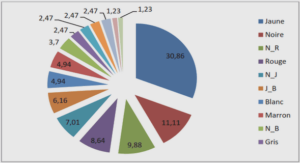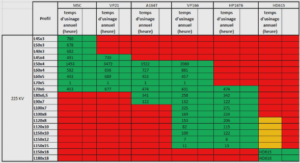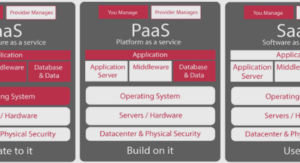Formation the concept of guerilla marketing, tutoriel & guide de travaux pratiques en pdf.
The effects of guerilla marketing on brand equity
The example illustrated below discusses the practice of guerrilla marketing and the events surrounding the failed marketing ploy for the television show « Aqua Teen Hunger Force. » The effectiveness and dangers of innovative and alternative guerrilla marketing on the brand equity are discussed and where the Boston event seeking to point out where the project went too far.
On January 31, 2007, a battery-powered device about a foot square, with dangling wires and glittering lights, was found in a main interaction of Boston. Vast resources were soon assembled in the city to investigate the suspicious threat. « At the height of the alert, » a police officer noted, « authorities mobilized emergency crews, federal agents, bomb squads, hundreds of police and the US Coast Guard…roads, bridges, and even part of the Charles River were closed ». Manpower, time, and money were devoted to protecting the city from a suspected terrorist threat that turned out to be nothing more than a marketing ploy.
The perceived dangerous devise displayed a boxy cartoon character giving an obscene hand gesture to promote the late-night cartoon, Aqua Teen Hunger Force, a surreal series on Turner Broadcasting System’s Cartoon Network about « a talking milkshake, a box of fries and a wad of meat ». The same light boards had also been placed for two to three weeks in New York, Los Angeles, Chicago, Atlanta, Seattle, Portland, Austin, San Francisco, and Philadelphia as part of a guerrilla marketing campaign implemented by Turner’s third-party marketing firm, Interference.
Following immense media coverage and finger pointing, a deal was announced in which Turner Broadcasting and Interference would pay $1 million to reimburse state, federal and local law enforcement agencies for the cost of responding to the « threat. » In addition, Turner would allocate $1 million in goodwill funds for security and community programs. The individuals who positioned the light boards around the city were originally charged with placing a hoax device resulting in panic and disorderly conduct. Under the agreement, Turner, Interference, and anyone representing the companies, would not face any charges.
Blogs, attention-getting street graphics, strange occurrences and memorable events are some of the tools of the guerilla marketer. But the very best guerilla strategy directed at the wrong audience or for the wrong reason won’t accomplish a thing. In fact, it can actually hurt the brand. Guerilla marketing should thus start with careful planning
Guerrilla marketing in entrepreneurial ventures
Entrepreneurial marketing is used as an integrative conceptualization that reflects such alternative perspectives as guerrilla marketing, radical marketing, expeditionary marketing, disruptive marketing and others. Seven core dimensions of EM are identified, and an underlying theoretical foundation based on resource advantage theory is proposed. A conceptual model is introduced of key factors surrounding the phenomenon of entrepreneurial marketing. The merging of the entrepreneurship and marketing disciplines has important implications in terms of business ethics. The very nature of entrepreneurial behavior requires vigilance on the part of the marketer in terms of adherence to an ethical standard. Another implication of EM concerns the way in which future marketers are trained.
Effective marketing today requires different strategies at different stages and makes a distinction between « entrepreneurial marketing » or guerrilla, grassroots marketing in the early stages of company development, and « intrapreneurial marketing » or creative, non-formulaic marketing in
the later stages. In spite of these various uses of the term, a consistent definition has not been promulgated, nor have the underlying components of the construct been specified.
For our purposes, entrepreneurial marketing is proposed as an integrative construct for conceptualizing marketing in an era of change, complexity, chaos, contradiction, and diminishing resources, and one that will manifest itself differently as companies age and grow. It fuses key aspects of recent developments in marketing thought and practice with those in the entrepreneurship area into one comprehensive construct.
Entrepreneurial marketing results in « guerrilla » approaches to the individual elements of the marketing mix, creative methods of resource leveraging, and a variety of techniques for managing or mitigating risks.
Marketers must develop a personal approach to the identification and pursuit of entrepreneurial opportunity. The approach must reflect skills in obtaining sponsors, building a flexible team structure, insulating projects, building project momentum, obtaining resources that have not been formally assigned to a project, developing internal support networks, and managing expectations.
Guerrilla marketing in SMEs
Small and medium-sized firms face disadvantages in the dynamic global market place today. The authors suggest that « fast cycle decision making » can create economic advantages that will allow the smaller firm to aggressively compete against much larger rivals. Fast cycle decision making suggests deception, rapid response and being able to « turn inside » your opponent’s decision cycle.
Guerrilla decision making focuses resources on objectives quickly, effectively, and efficiently, with goal orientation being more long-term than near-term guerrilla. By extension, large institutional decision making and strategy development fail in one or more of these basic characteristics. Decision making at the SME level is by its very nature a rapid, iterative, interactive responsibility process involving people and their dependent, independent, and interdependent relationships to the various environments (internal and external) that tend to shape, reshape, and disrupt the various elements of doctrinal strategy and policy on a painfully persistent basis. Organizations will be required to adopt flatter structures, greater empowerment, and substantially more high-speed, reduced-cycle decisions at all levels. Guerrilla techniques, when examined, may provide a platform for extension and expansion of rapid, asynchronous, decision-making models.
At the most basic, guerrilla activities are the practical methods of achieving objectives that differ little from the more conventional strategic objectives. Guerrilla decisions should, in an analytical sense, compliment doctrinal strategy. Fundamentally, guerrilla decisions and activities provide greater flexibility, variability, and adjustability during the entrepreneurial struggle of most (if not all) SME existence. The long-term objectives remain constant in the long-run: (1) profitability for growth and development; (2) marketability for the purpose of creating and maintaining customer satisfaction; and (3) organizational stability for cultural harmony and health. Still, there are few, yet basic, principles that should be introduced so that all activities are not attributed to guerrilla for the sake of dismissive expedience.
The first set of principles considered provides the framework of contemporary SME and is not intended to support any specific type of guerrilla decision. Too often guerrilla tactics in business are seen as being specifically designed to dismantle and not merely disrupt. The author(s) suggest that while there is a disequilibrium that may occur in the wake of guerrilla decisions, the intent is to formulate a more rapid decision-making and competitive response process. The principles posited are adapted from those promoted by Ernesto “Che” Guevara, the Argentine-born revolutionary, in his treatise on guerrilla warfare in 1961. They are:
Principle 1: Popularly demanded products and services can extract considerable market responsiveness when confronted by larger corporate product and service offerings.
Principle 2: It is not necessary to wait for all conditions to be strategically aligned to implement guerrilla activity decisions.
Principle 3: The local/community market-place is the best and most basic area for guerrilla activity success.
Of these three basic principles, the first directly contradicts the general business wisdom embedded in Porter’s Five-Factor Model of Market profitability, which suggests that the number of competitors, their size, and their commitment of resources will determine the intensity of
competition. While it is imperative that the issues of viability remain foremost, the guerrilla can survive and thrive in a more structured strategic environment of larger, more dominant organizations without spending inordinate resources concentrating on the combined effect of these profitability variables. This contradiction does not negate the strategic importance of the five factors; rather the contradiction provides the impetus for action at a level that does not depend upon size or power of the participant.
The second principle provides the platform for action. While economists and strategic theorists promote the benefit of strategic alignment, the guerrilla very often possesses neither the resource capability nor the competitive position to wait.
Herein it is important to assert that guerrilla activities are actions of precision and not actions of dominance. For the SME, time is critical, and decisions must be made without perfect information or strategic resources.
Together these first two basic principles provide the morale boost to empower and enable SMEs to engage selectively and decisively. Guerrilla activities help the SME decision making to crystallize more effectively around specific target markets, specific objectives, and with specific metrics of success, significantly more so than the slower, vaguer and often abstract aspects of corporate, strategic decision making.
Additionally, the third principle is fundamentally a proposition of location of action. Too often, larger, more global organizations will dogmatically opt for the large, aggregated population characteristics and forget or neglect the immense power associated with smaller, more localized communities.
OODA loop
OODA is an acronym for Observation, Orientation, Decision, and Action. This sequence of individual and/or organizational cognitive processes is also referred to as the “Boyd Cycle” because it is attributed to the late Colonel John R. Boyd, a pioneering jet-fighter pilot and strategic theorist with the U.S. Air Force. OODA Loop model fits highly dynamic, competitive decision methods wherein the decision maker intuitively maps operational flows, seeks ways of reducing critical path implementation time of competitive activity, and closely monitors progress. Entrepreneurs and guerrillas, like successful fighter pilots, enter new competitive encounters employing the mindtime-space relationship of variety, rapidity, harmony, and initiative to attain a specific objective.






